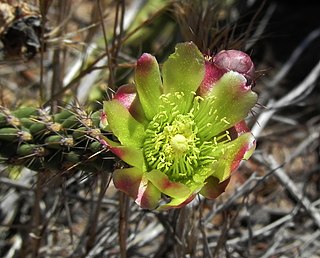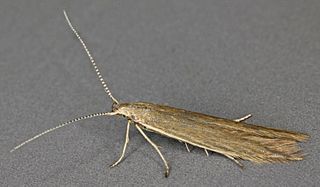
The cinnabar moth is a brightly coloured arctiid moth found as a native species in Europe and western and central Asia then east across the Palearctic to Siberia to China. It has been introduced into New Zealand, Australia and North America to control ragwort, on which its larvae feed. The moth is named after the red mineral cinnabar because of the red patches on its predominantly black wings. The species was first described by Carl Linnaeus in his 1758 10th edition of Systema Naturae. Cinnabar moths are about 20 mm (0.79 in) long and have a wingspan of 32–42 mm (1.3–1.7 in).

The Pyralidae, commonly called pyralid moths, snout moths or grass moths, are a family of Lepidoptera in the ditrysian superfamily Pyraloidea. In many classifications, the grass moths (Crambidae) are included in the Pyralidae as a subfamily, making the combined group one of the largest families in the Lepidoptera. The latest review by Eugene G. Munroe and Maria Alma Solis retain the Crambidae as a full family of Pyraloidea.

Cylindropuntia is a genus of cacti, containing species commonly known as chollas, native to northern Mexico and the Southwestern United States. They are known for their barbed spines that tenaciously attach to skin, fur, and clothing. Stands of cholla are called cholla gardens. Individuals within these colonies often exhibit the same DNA, as they were formerly tubercles of an original plant.

Emmelina monodactyla is a moth of the family Pterophoridae found in Africa, Asia, Europe and North America. It was first described by Carl Linnaeus in 1758.

The hemlock moth, also known as the defoliating hemlock moth or poison hemlock moth, is a nocturnal moth species of the family Depressariidae. Of Palaearctic origin, it was first found in North America in 1973 when it was accidentally introduced. The moth is now widespread throughout the northern half of the United States, southern Canada, northern Europe, and, more recently, New Zealand and Australia. The larval form grows to around 10 mm, while the adults wingspan is between 17 mm and 19 mm.

Pseudoschinia is a genus of moths of the family Crambidae. It contains only one species, Pseudoschinia elautalis, which is found in North America, where it has been recorded from Arizona, California, Nevada, New Mexico and Texas.

Actebia fennica, the black army cutworm or Eversmann's rustic, is a moth of the family Noctuidae. The species was first described by August Michael Tauscher in 1806. It has a Holarctic distribution from Newfoundland through western Europe, Siberia, the Far East, Mongolia, northern China to Korea and Japan. In North America it is mainly found in the boreal region, south to New England, southern Montana and northern Oregon.

Cylindropuntia californica is a species of cholla cactus known by the common name snake cholla. It is primarily found in Baja California, Mexico and the southernmost part of California in the United States. It is characterized by a short, decumbent habit, yellow-green flowers, elongated stems, and short spines. It is mostly found in coastal sage scrub and coastal chaparral habitats, but two varieties in Baja California can be found in foothills and deserts. In California, variety californica is regarded as a rare and threatened plant, with a California Native Plant Society listing of 1B.1, in part due to its limited number of occurrences and threats from development. It formerly was considered to have a larger range due to the inclusion of Cylindropuntia bernardina within it as the variety parkeri.

Cylindropuntia ramosissima is a species of cactus known by the common names diamond cholla and branched pencil cholla.

Epiblema strenuana, the stem-galling moth or ragweed borer, is a moth of the family Tortricidae. It is endemic to North America, but was introduced to Australia from Mexico to control the weeds of the family Asteraceae in 1982. It is occasionally misspelled as Epiblema strenuanum.
Coleophora parthenica, the Russian thistle stem miner moth, is a moth of the family Coleophoridae. It is native to North Africa, the Middle East and Asia, including Pakistan, Egypt and Turkey. It is an introduced species in the United States in California, Nevada, Utah, Idaho, Arizona and Hawaii. It has been introduced intentionally as a biological control of invasive Salsola species.

Coleophora alticolella is a moth of the family Coleophoridae, found in Europe and North America.

Cahela is a monotypic snout moth genus described by Carl Heinrich in 1939. Its only species, Cahela ponderosella, the cahela moth, described by William Barnes and James Halliday McDunnough in 1918, is found in Mexico and in the US states of California, Texas, Arizona, Utah and probably Nevada.
Alberada bidentella is a species of snout moth in the genus Alberada. It was described by Harrison Gray Dyar Jr. in 1908, and is known from the south-western United States from Texas westward.
Alberada parabates is a species of snout moth in the genus Alberada. It was described by Harrison Gray Dyar Jr. in 1913, and is known in North America from Arizona, California, Colorado, New Mexico, Oklahoma, Texas and Mexico.
Zophodia substituta is a species of snout moth in the genus Zophodia. It was described by Carl Heinrich in 1939. It is found in Peru.
Rumatha jacumba is a species of snout moth in the genus Rumatha. It was described by Herbert H. Neunzig in 1997. It is found in North America, including California and Nevada.
Rumatha bihinda is a species of snout moth in the genus Rumatha. It was described by Harrison Gray Dyar Jr. in 1922. It is found in North America, including California, Texas, New Mexico, Arizona and Nevada.
Rumatha glaucatella is a species of snout moth in the genus Rumatha. It was described by George Duryea Hulst in 1888. It is found in North America, including southern Texas and Florida.

Pandemis lamprosana, the woodgrain leafroller moth, is a species of moth of the family Tortricidae. It is found in North America, where it has been recorded from the north-eastern United States, Quebec and Ontario.












